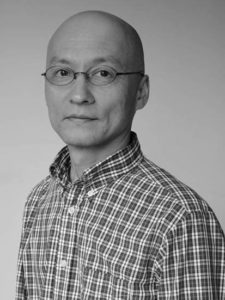
Professor. Department of Educational Psychology,
Graduate School of Education, University of Tokyo, Japan
Director. University of Tokyo Art Center
Research Overview
My research focuses on the artistic creation process of artists in visual art, dance, and other domains using a multi-method approach with field studies and psychological experiments. I also study art education and learning processes, especially in art museums and undergraduate liberal arts education, using a design-based research method.
Also, I am the director of the Art Center at the University of Tokyo which has been established in 2019. It aims to conduct research and education integrating art with natural and social sciences and humanities.
Selected Publications
Books
- Komatsu, K. Takagi, H. Ishiguro & T. Okada (Eds.). (2022). Arts-Based Method in Education Research in Japan. Leiden: Brill
Knutson, T. Okada, & K. Crowley (Eds.). (2020) Multidisciplinary Approaches to Art Learning and Creativity: Fostering Artistic Exploration in Formal and Informal Settings. Routledge.
Crowley, C. D. Schunn, & T. Okada (Eds.). (2001) Designing for Science: Implications from everyday, classroom, and professional settings. Mahwah, NJ: Erlbaum.
Book Chapters
Ishiguro, C. & Okada, T. (2018). How can inspiration be encouraged in art learning? In T. Chemi, & X. Du (Eds.) Arts-based methods and organizational learning: Higher education around the world. 205-230. River publisher.
Nomura, R. & Okada, T. (2016). Assessing the appeal power of narrative performance by using eyeblink synchronization among audience. In T. Ogata & Akimoto, T. (Eds.), Computational and Cognitive Approaches to Narratology, Edition: 1, IGI Global.
Schunn, C. D., Crowley, K., & Okada, T. (2005) Cognitive Science: Interdisciplinarity now and then. In S. J. Derry, C. D. Schunn, & M. A. Gernsbacher (Eds.), Interdisciplinary Collaboration: An Emerging Cognitive Science (pp. 287-315). Mahwah, NJ: Erlbaum.
Schunn, C., Crowley, K., & Okada, T. (2002) What makes collaborations across a distance succeed?: The case of the cognitive science community. In P. Hinds & S. Kiesler, Distributed work (pp. 407-430). Cambridge, MA: MIT Press.
Articles
Matsumoto, K., & Okada, T. (2019). Viewers recognize the process of creating artworks with admiration: Evidence from experimental manipulation of prior experience. Psychology of Aesthetics, Creativity, and the Arts. https://doi.org/10.1037/aca0000285
Shimizu, D., & Okada, T. (2018). How do creative experts practice new skills? Exploratory practice in breakdancers. Cognitive Science,42(7), 2364-2396. doi: 10.1111/cogs.12668
Okada, T. & Ishibashi, K. (2017). Imitation, inspiration, and creation: Cognitive process of creative drawing by copying others’ artworks. Cognitive Science. doi:10.1111/cogs.12442
Ishiguro, C., Yokosawa, K., & Okada, T. (2016). Eye movements during art appreciation by students taking a photo creation course. Frontiers in Psychology, 7:1074. doi: 10.3389/fpsyg.2016.01074
Nomura, R., Liang, Y., and Okada, T. (2015). Interactions among collective spectators facilitate eyeblink synchronization. PLoS ONE. 10 :e0140774, doi: 10.1371/journal.pone.014774.
Nomura, R., Hino, K., Shimazu, M., Liang, Y., & Okada, T (2015). Emotionally excited eyeblink-rate variability predicts an experience of transportation into the narrative world. Frontiers in Psychology. doi: 10.3388/fpsyg.2015.0447.
Okada, T., Yokochi, S., Ishibashi, K., & Ueda, K. (2009) Analogical modification in the creation of contemporary art. Cognitive Systems Research, 10(3), 189-203.
Yokochi, S., & Okada, T. (2005) Creative cognitive process of art making: A field study of a traditional Chinese ink painter. Creativity Research Journal, 17, 241-255.
Schunn, C. D., Crowley, K., & Okada, T. (1998) The growth of multidisciplinarity in the Cognitive Science Society. Cognitive Science, 22, 107-130.
Okada, T. & Simon, H. A. (1997) Collaborative discovery in a scientific domain. Cognitive Science, 21(2), 109-146.
Okada, T. & Yokochi, S., (2024) Process Modification and Uncontrollability in an Expert Contemporary Artist’s Creative Processes. The Journal of Creative Behavior. https://doi.org/10.1002/jocb.635
Wang, S., Okada, T., & Takagi, K., (2023). How to effectively overcome fixation: a systematic review of fixation and defixation studies on the basis of fixation source and problem type. Frontiers in Education, https://doi.org/10.3389/feduc.2023.1183025
Vinchon, F., Lubart, T., Bartolotta, S., Gironnay, V., B otella, M., B ourgeois-Bougrine, S., Jean-Mariburkhardt, Bonnardel, N., Corazza, G. M., Glaveanu, V., Hanson, M. H., Ivcevic, Z., Karwowski, M., Kaufman, J., Okada, T., Reiter-Palmon, R., & Gaggioli, A., (2023). Artificial Intelligence and creativity: A manifesto for collaboration. Journal of Creative Behavior, https://doi.org/10.1002/jocb.597
Sun, J., and Okada, T. (2022). Interaction in acting training and its different manifestations in novice and professional actors. Frontiers in Psychology, 13, 949209. https://doi.org/10.3389/fpsyg.2022.949209
Wang, S., Takagi, K., & Okada, T. (2022). Effect of modifying the process of creating on novices’ creativity in drawing. Thinking Skills and Creativity, 44, https://doi.org/10.1016/j.tsc.2022.101008
Shimizu, D., & Okada, T. (2021). Synchronization and Coordination of Art Performances in Highly Competitive Contexts: Battle Scenes of Expert Breakdancers. Frontiers in Psychology, 12, 635534
Sun, J., & Okada, T. (2021). The process of interactive role-making in acting training. Thinking Skills and Creativity, 41, https://doi.org/10.1016/j.tsc.2021.100860
Matsumoto, K., & Okada, T. (2021). Imagining how lines were drawn: The appreciation of calligraphy and the facilitative factor based on the viewer’s rating and heart rate. Frontiers in Human Neuroscience, 366.
Yokochi, S., & Okada, T. (2021). The process of art-making and creative expertise: An analysis of artists’ process modification. The Journal of Creative Behavior. https://doi.org/10.1002/jocb.472
Ishiguro, C. & Okada, T. (2020). How does art viewing inspire creativity? The Journal of Creative Behavior. https://doi.org/10.1002/jocb.469
Matsumoto, K., & Okada, T. (2019). Viewers recognize the process of creating artworks with admiration: Evidence from experimental manipulation of prior experience. Psychology of Aesthetics, Creativity, and the Arts. https://doi.org/10.1037/aca0000285
Shimizu, D., & Okada, T. (2018). How do creative experts practice new skills? Exploratory practice in breakdancers. Cognitive Science,42(7), 2364-2396. doi: 10.1111/cogs.12668
Okada, T. & Ishibashi, K. (2017). Imitation, inspiration, and creation: Cognitive process of creative drawing by copying others’ artworks. Cognitive Science. doi:10.1111/cogs.12442
Okada, T., Yokochi, S., Ishibashi, K., & Ueda, K. (2009) Analogical modification in the creation of contemporary art. Cognitive Systems Research, 10(3), 189-203.
Yokochi, S., & Okada, T. (2005) Creative cognitive process of art making: A field study of a traditional Chinese ink painter. Creativity Research Journal, 17, 241-255.
